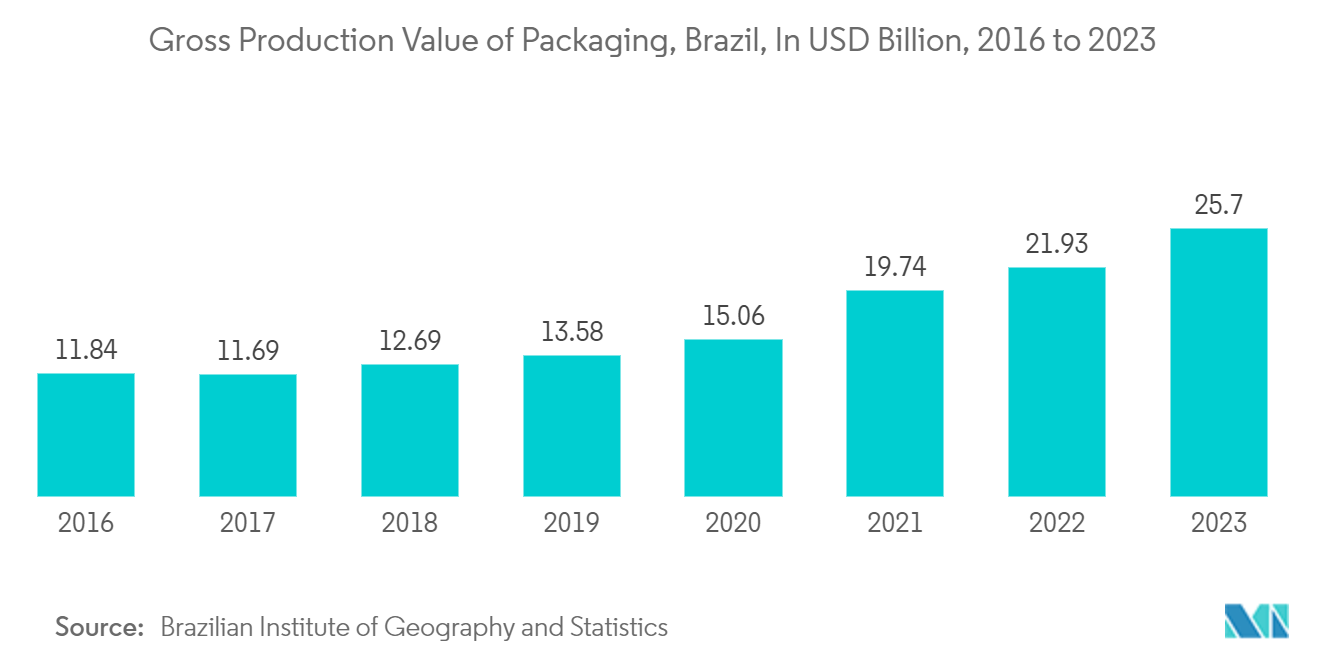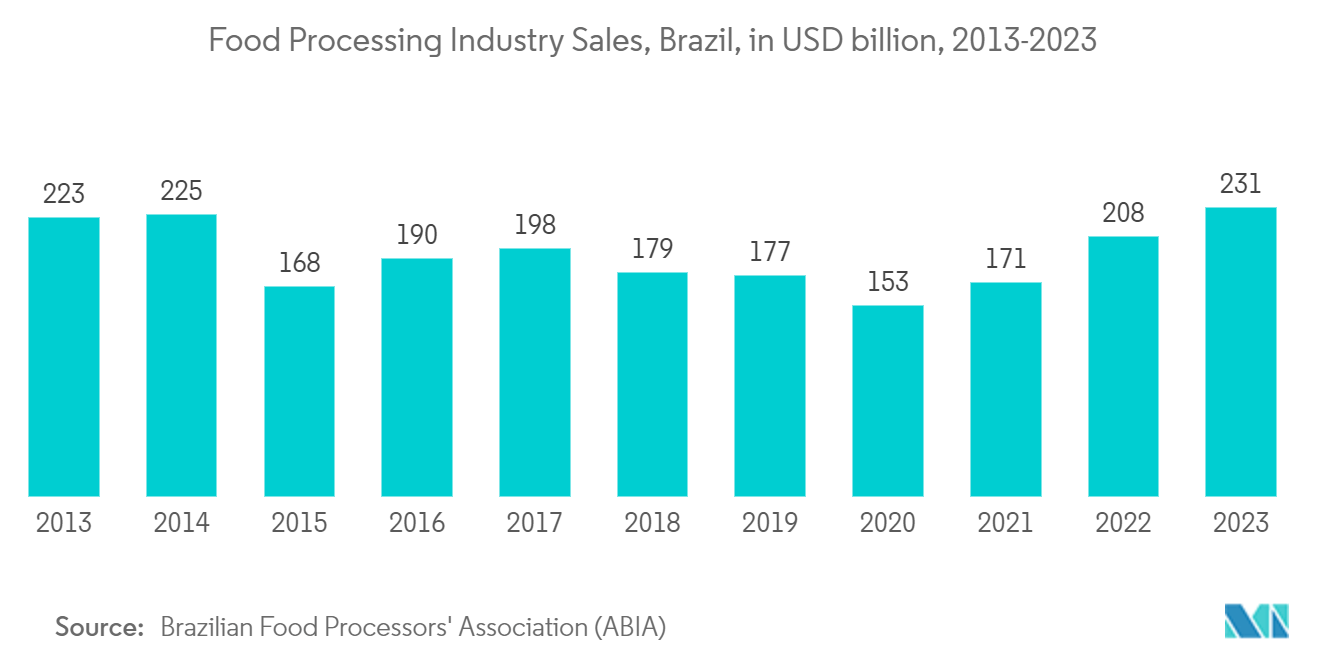Market Trends of Brazil Plastic Packaging Industry
The PE Segment is Expected to Hold a Significant Market Share
- Polyethylene (PE), recognized for its flexibility and recyclability, is widely utilized across various industries. Its cost-effectiveness and versatility render it a favored choice for packaging and protective materials. Its adaptability has contributed to the expansion of its usage in Brazil, particularly in plastic bags, wraps, and a range of packaging solutions catering to all end-user segments. Additionally, the rising investments in industries such as food and beverages are anticipated to further propel market growth.
- With the increasing population of Brazil, the necessity for effective transportation, safeguarding, and preservation of products from their source to the consumer's location has become critical. This requirement has driven innovations in processing and preservation methods, resulting in the growth of the market. According to Brazilian Plastics, Brazil is the seventh-largest consumer of plastics globally. Braskem, a key market leader, has established a significant presence in Brazil's resin market. Furthermore, the plastics conversion industry in Brazil comprises approximately 11,000 converters.
- The expansion and advancement of the packaging industry are expected to further stimulate the growth of the PE segment. The Brazilian Flexible Plastic Packaging Industry Association (ABIEF) reported that per capita consumption of plastic packaging in Brazil increased by 2.5% in 2023, reaching an average of 10.6 kilograms per individual annually. The food industry is the primary consumer of plastic packaging in the nation. In 2023, the gross production value of Brazil's packaging industry was BRL 144.4 billion (USD 25.70 billion), an increase from BRL 123.20 billion (USD 21.93 billion) in 2022.
- In July 2023, Braskem successfully completed a 30% expansion of its bio-based ethylene facility, following an investment of USD 87 million in Rio Grande do Sul, Brazil. This expansion increased the plant's capacity from 200,000 to 260,000 tons annually, strategically addressing the rising demand for sustainable solutions. Braskem's bio-based ethylene not only contributes to product development but also plays a crucial role in capturing CO2 from the atmosphere. With an ambitious goal, Braskem intends to elevate its biopolymer production to one million tons by 2030 and achieve carbon neutrality by 2050.
- End-user industries such as cosmetics and personal care are expected to drive the demand for PE packaging solutions in Brazil. The growing investments in boosting the production of personal care products across the region are expected to drive the segment’s growth. In April 2024, MercadoLibre announced its intention to invest BRL 23 billion (USD 4.6 billion) in the Brazilian market. This investment represented a significant 21.1% increase compared to the previous year, highlighting the online retailer's dedication to strengthening its presence in this vital market. Additionally, as polyethylene packaging becomes increasingly important in the beauty industry, offering reusable, resealable, and easily dispensable options, the rising investments in the industry are expected to enhance demand.
- The increasing consumer preferences for personal care products are anticipated to boost the demand for aesthetically pleasing packaging, consequently propelling the growth of this segment. As reported by the Brazilian Association of the Toiletries, Perfumery, and Cosmetics Industry (ABIHPEC), Brazil's exports of personal care items surged by more than 17% quarter-over-quarter in the first quarter of 2023. This upward trend in personal care product exports is likely to generate growth opportunities for manufacturers of consumer packaging.
- World Bank indicated that the agricultural sector's share of Brazil's gross domestic product (GDP) rose from 5.77% in 2022 to 6.24% in 2023. Beyond their primary function in packaging, polyethylene (PE) materials are widely utilized as greenhouse films within the sector. Furthermore, the initiatives launched by the Ministry of Agriculture in 2023, which focus on decreasing carbon emissions in agriculture and enhancing sustainability, are anticipated to stimulate the demand for PE packaging in greenhouse farming. These critical elements are also projected to create significant market opportunities.

The Food Segment is Expected to Hold a Significant Market Share
- Plastic packaging is extensively utilized in the food and beverage industry. Its remarkable moisture resistance and capacity to preserve freshness make it suitable for a wide range of products, including fresh fruits and vegetables, frozen items, and liquids. According to the USDA, Brazil's gross domestic product (GDP) reached USD 2.17 trillion in 2023, reflecting a growth of 2.9% compared to the previous year, with significant contributions from the food and beverage industry. The anticipated increase in production capacity and export levels within this industry is expected to drive the demand for plastic packaging.
- The food industry in Brazil is experiencing consistent growth, propelled by swift urbanization and an increasing preference for packaged food products. According to the Brazilian Food Processors Association (ABIA), the food processing industry generated revenues amounting to USD 231 billion in 2023, marking a 7.2% rise compared to the prior year. This revenue represented 10.8% of the country's GDP. The industry comprises over 38,000 businesses, primarily small and medium-sized enterprises. These significant developments within the industry are expected to generate considerable market opportunities.
- The perceptions of Brazilian consumers regarding food packaging have undergone considerable transformation in recent years. This change is largely influenced by the increasing awareness of environmental issues, health factors, and evolving lifestyle trends. A detailed report entitled “Percepção do consumidor com relação à embalagem de alimentos: tendências” explored the shifting preferences in food packaging among Brazilian consumers. Consumers are increasingly leaning toward products that feature environmentally friendly packaging, encompassing materials that are biodegradable, recyclable, or derived from sustainable sources.
- Moreover, the report suggested that, as the significance of sustainability increasingly resonates with consumers, food packaging practices are anticipated to develop further. Manufacturers who proactively adapt to these trends and emphasize consumer preferences are likely to thrive in a dynamic market environment. Consequently, food manufacturers are reassessing their packaging designs to meet the demands of consumers who prioritize convenience and accessibility. The report indicated that Brazil will remain a focal point for investment by packaging companies like Novelis, Duravant, and SIG.
- The growth of the segment can be attributed to the increased awareness among Brazilian consumers about healthy eating habits, a rising demand for organic and sustainable products, and a growing consciousness regarding consumer health. Although the GDP growth forecast for 2024 remains conservative, the outlook for the food industry appears optimistic. ABIA anticipates a growth rate of 1.2% in the coming year despite persistent challenges associated with elevated production costs.
- Similarly, the growing investments by leading food companies in the region to improve production capabilities are expected to stimulate demand for packaging materials. In December 2023, Nestlé announced its plan to invest USD 1.2 billion in the production of food and beverages in Brazil. The company indicated that various investments will be executed from 2023 to 2025. These efforts were designed to foster "business growth, portfolio transformation, and operational efficiency" in its food offerings within the country. The allocated funds will focus on increasing production capacity and promoting "innovation in products and packaging."
- The use of various plastic packaging items, such as bottles and jars, is expected to experience considerable growth in the region's milk industry. According to FAO, Brazil, which is one of the foremost milk producers worldwide, will generate significant demand for polyethylene packaging films. According to the USDA, milk production increased by roughly 4.3% in 2023, reaching a total of 24.7 million metric tons (MMT). In 2024, milk production is expected to increase by approximately 1.2%, culminating in a total of 25 MMT.


